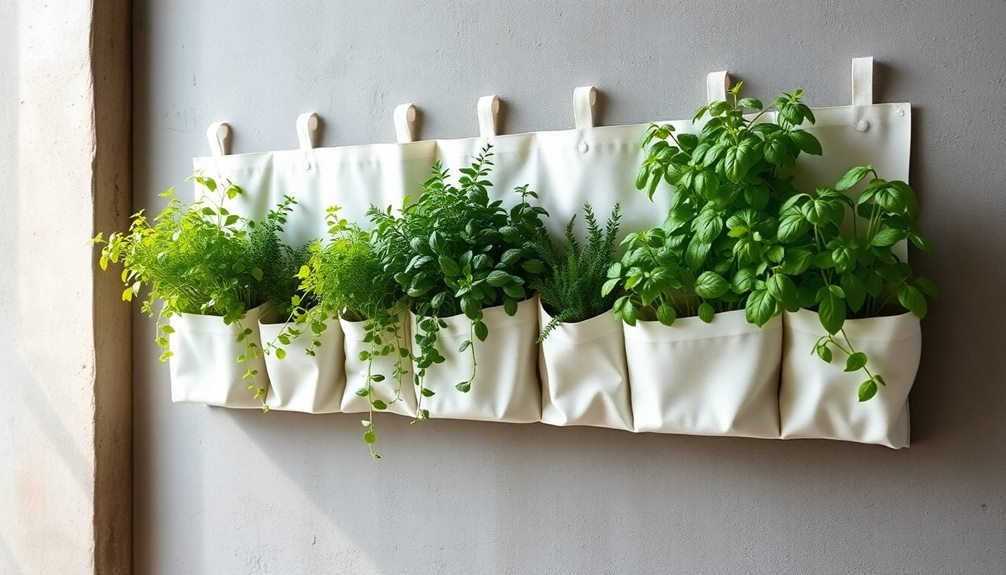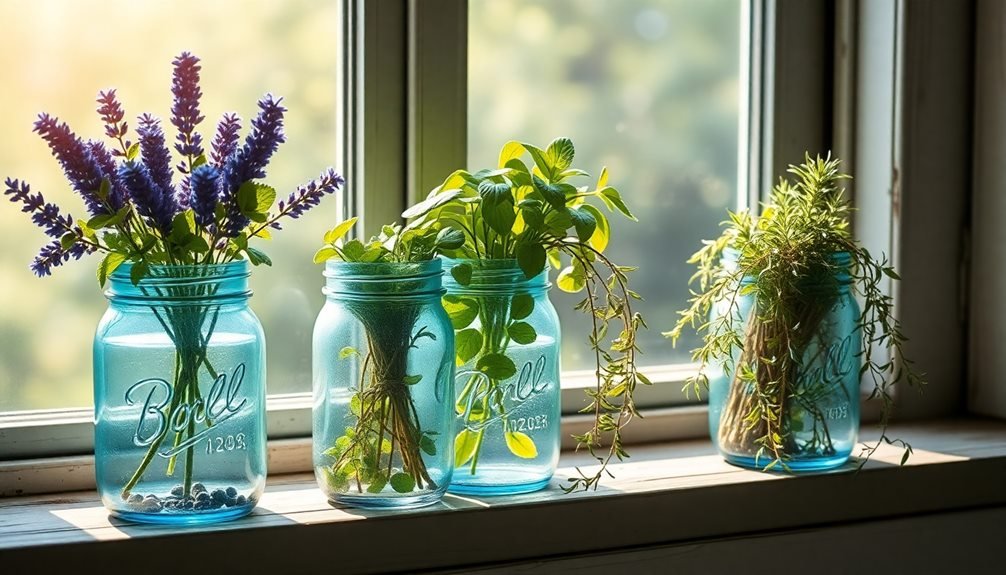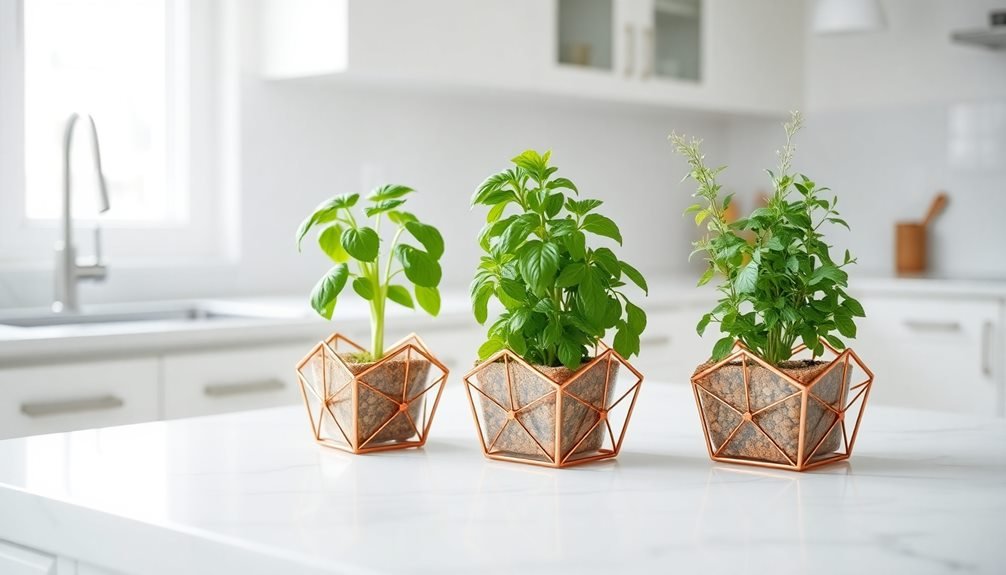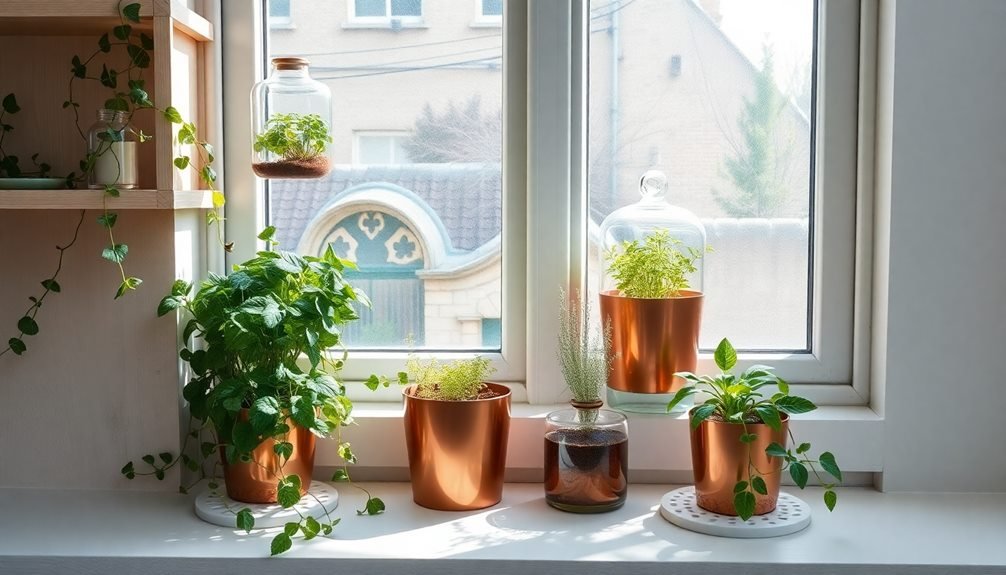Transform your tight living space into a calming herbal retreat with five innovative garden designs. You'll maximize vertical space with a fabric pocket garden for sun-loving herbs, or create a serene windowsill Zen garden using river stones and mindful arrangements. Mason jar aromatherapy gardens bring therapeutic benefits through calming herbs like lavender and rosemary, while vintage teacup displays add whimsical charm to smaller spaces. For a modern touch, try a minimalist kitchen counter garden with sleek planters and carefully curated herbs. These space-saving solutions offer more than just fresh ingredients—they'll help you cultivate your own peaceful sanctuary.
Vertical Wall Pocket Garden

A cascade of fresh herbs can transform your bare wall into a living tapestry with a vertical wall pocket garden. Using fabric pockets or modular plastic containers mounted securely to your wall, you'll create a space-efficient garden that doubles as living artwork.
The vertical design maximizes growing space while minimizing floor footprint, making it perfect for small apartments or cramped kitchens.
Choose herbs that thrive in your indoor environment's lighting conditions. Place sun-loving herbs like basil, oregano, and thyme in the upper pockets where they'll receive more light. Reserve lower pockets for shade-tolerant herbs such as mint, parsley, and chives.
You'll need to install proper drainage systems to prevent water damage to your walls, and position a catch tray at the bottom to collect excess water.
Water your vertical garden carefully, starting from the top pockets and allowing excess moisture to trickle down. You'll find that herbs in the upper pockets may need more frequent watering due to faster evaporation.
Monitor soil moisture levels regularly and trim your herbs often to encourage bushier growth and prevent them from becoming leggy.
Windowsill Zen Garden
Combining style with simplicity, your windowsill herb garden can embody the principles of Zen design while providing fresh culinary herbs at arm's reach. Select low-profile containers in neutral tones, and arrange them asymmetrically to create visual interest. You'll want to incorporate elements like smooth river stones or fine gravel to maintain moisture and add meditative appeal.
| Herb Type | Light Needs | Zen Benefits |
|---|---|---|
| Lavender | Full sun | Calming scent |
| Rosemary | 6+ hours sun | Mental clarity |
| Mint | Partial shade | Stress relief |
| Sweet Basil | Full sun | Energy balance |
Choose herbs that thrive in your window's light conditions and complement your cooking style. You'll find that caring for these plants becomes a mindful practice – from gentle pruning to mindful watering. Group your herbs in odd numbers, following the Japanese principle of asymmetrical balance. Add small bamboo stakes for structural support, and consider incorporating a mini rake for maintaining the gravel surface. This combines functionality with the meditative aspects of traditional Zen gardens, creating a peaceful focal point in your kitchen that engages all your senses.
Mason Jar Aromatherapy Garden

Mason jars transform into charming vessels for an aromatic indoor garden that doubles as natural air fresheners.
You'll need wide-mouth quart-size jars, quality potting soil, proper drainage materials, and your chosen aromatherapy herbs. Place the jars near a sunny window, and you'll soon enjoy both the visual appeal and therapeutic benefits of your fragrant mini-garden.
Select herbs that thrive indoors and offer calming properties. You can grow multiple varieties in separate jars, creating a customized aromatherapy collection that suits your needs.
Remember to drill drainage holes in jar lids or layer the bottom with pebbles to prevent root rot.
- Lavender – promotes relaxation and better sleep
- Rosemary – improves focus and memory
- Lemon balm – reduces stress and anxiety
- Holy basil (tulsi) – balances mood and boosts immunity
- Peppermint – increases energy and aids digestion
Water your herbs when the top inch of soil feels dry, and mist the leaves occasionally to maintain humidity.
Trim your plants regularly to encourage bushier growth and release their aromatic oils. You can use the fresh cuttings for teas, potpourri, or natural room sprays, maximizing the benefits of your aromatic garden.
Hanging Teacup Herb Display
While mason jars offer practical herb growing solutions, vintage teacups bring whimsical charm to your indoor garden space.
You'll find these delicate containers perfect for growing smaller herbs like thyme, mint, or chamomile. To create your hanging display, drill small drainage holes in vintage teacups using a ceramic drill bit, and secure strong twine or thin rope through the cup handles.
You'll need to mount sturdy hooks into your ceiling joists or wall studs to support the weight of the soil, plants, and water. Choose lightweight potting mix specifically formulated for herbs, and fill each cup about three-quarters full.
When planting, make certain you don't overcrowd the cups – one to two herb seedlings per container is ideal.
Position your teacup garden near a window that receives at least six hours of sunlight daily. You can create visual interest by hanging cups at varying heights and mixing different teacup patterns.
Water carefully to avoid overflow, and place small saucers inside each cup to catch excess moisture. Remember to trim your herbs regularly to maintain their compact size and prevent them from becoming too heavy for the teacups.
Minimalist Kitchen Counter Garden

A sleek kitchen counter garden delivers fresh herbs without visual clutter. You'll need only a slim rectangular planter, preferably in white or brushed metal, to create this modern growing space.
Position it near a window that gets at least 4-6 hours of sunlight daily, or supplement with LED grow lights mounted underneath your cabinets.
Choose herbs that complement each other in height and growing requirements. Stick to a limited palette of 3-4 herbs to maintain the minimalist aesthetic.
To maximize your counter space, select a planter that's no more than 4 inches deep and 24 inches long.
Essential elements for your minimalist herb garden:
- A single-row planter with built-in drainage system
- White pea gravel for top dressing and visual consistency
- Moisture-retaining potting mix specifically for herbs
- Clear plant markers that blend seamlessly with the design
- A small watering can that doubles as decorative accent
Maintain the garden's clean lines by regularly trimming herbs to an even height.
When harvesting, cut from the outside stems inward to preserve the structured appearance. This approach guarantees your counter garden remains both functional and visually appealing year-round.
Frequently Asked Questions
How Long Can Indoor Herb Gardens Typically Survive Without Direct Sunlight?
Your indoor herbs can survive 2-4 weeks without direct sunlight, but they'll struggle and decline. You'll need at least 4-6 hours of bright indirect light daily for them to thrive long-term.
Will Herb Gardens Attract Insects to My Living Space?
You'll likely see some harmless insects around your herbs, but they won't swarm your space. Using organic pest control methods and proper ventilation can minimize any unwanted visitors while growing your plants indoors.
Which Herbs Should Not Be Planted Together in Small Spaces?
You shouldn't plant mint with other herbs as it'll aggressively take over. Keep fennel away from dill and cilantro, and separate basil from rue. Rosemary and sage compete for nutrients when planted together.
How Often Should I Replace the Soil in Container Herb Gardens?
You'll need to replace your container herb garden's soil annually, but if you're seeing poor growth or drainage issues, don't wait. Mix in fresh compost every few months to maintain soil health.
Can Indoor Herbs Be Safely Used in Cooking Without Pesticides?
You can safely cook with indoor herbs without pesticides. Just rinse them thoroughly under cool water, pat them dry, and check for any unwanted bugs. Indoor growing typically needs fewer chemicals than outdoor gardens.
In Summary
You'll find these five compact herb garden designs fit seamlessly into your lifestyle while bringing nature's calming presence indoors. Whether you've chosen the vertical pockets, zen windowsill, aromatic jars, charming teacups, or minimalist counter display, you're now equipped to grow fresh herbs and create a peaceful green retreat. Let your indoor garden transform your space into a tranquil oasis, one herb at a time.





Leave a Reply